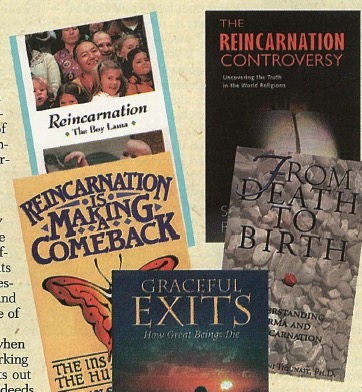BORN-AGAIN BOOKS
FIVE SCHOLARS EXPLORE THE SOUL’S REPEATED ENTRIES AND EXITS INTO AND FROM THE PHYSICAL FORM
By Tara Katir, Hawaii
To reincarnation desk–report for reassignment,” is a signboard in an episode of the popular Frank and Ernest comic strip. Ernest poses questions wondering how he will come back this time: As a brilliant scientist? A rich businessman? Or maybe “just as I am?” Frank quips, “Oh, I’m sure they’ll send you back as a completely different person….Nobody makes the same mistake twice!”
Americans’ affection for reincarnation is burgeoning. A 1989 Gallup Poll found that 58 percent either believe completely in rebirth or consider it a distinct possibility–and today the figure is riding at 72 percent. A peek in any large American bookstore reveals a plethora of books on rebirth. This law and its entwinement with the principle of karma is revealed in From Death to Birth, Understanding Karma and Reincarnation (216 pages, Himalayan Institute Press, US$15.95) by Pandit Rajmani Tigunait. A disciple of the late Swami Rama, Tigunait offers humorous and original insights into one of life’s most intriguing questions–what happens after we die? And how does karma affect the outcome of our next lifetime?
Sometimes we get discouraged when “bad” things happen while we’re working so hard to do good. Tigunait points out that these are the return of past misdeeds (in this or previous lives), and the solution is to create our future with “exceptional karmas”–positive karmas created by intense repetition of mantras, tapas (austerity), selfless service, the grace of God and the company of saints. These help us override our karmic destiny and change our life. “Such loopholes in the law of karma,” Tigunait jokes, release us from its bonds.
Besides resolving to enter our next life a few steps up the human evolutionary ladder, we should equally consider how to best exit this one. Should we be scared of death? Not if it’s approached with spiritual maturity. Sushila Blackman wanted to know how this is done, so she sought examples of great transitions, compiling and editing the uplifting Graceful Exits, How Great Beings Die, Death Stories of Tibetan, Hindu and Zen Masters (159 pages, Weatherhill Press, US$15.95). A devotee of Swami Muktananda, Blackman tells 108 soul-elevating true accounts of the remarkable ways ancient and modern spiritual giants departed this world. Especially esoteric is the narrative of the passing of Gyanamata, a nun of the Ramakrishna Order. Just before death she exclaimed, “What joy! What joy! Too much, too much joy!” Upon her passing, Paramahamsa Yogananda requested close disciples to feel her feet–which were very cold. Then he asked them to feel the top of her head, which felt as if it were on fire. Yogananda explained, “This shows she has left the body in the highest state of samadhi…the thousand-petaled lotus…she has no need to return to the world. But we’ll meet again.” Less than four months later Yogananda himself left his body.
While it’s not yet documented where Yogananda reincarnated (if he did at all), much of today’s world–thanks to the publicized Free Tibet movement–is fascinated to hear how Tibetan Buddhist monks track and validate the reappearance of their revered leaders. Vickie Mackenzie documents this process in the death of Lama Thubten Yeshe and his rebirth in Spain as Lama Osel in Reincarnation, the Boy Lama (175 pages, Wisdom Publications, US$16.95). You’ll follow events from the lives of Lama Yeshe and Lama Osel through testimonies of the Dalai Lama, fellow monks, devotees and the Spanish parents of Lama Osel. We learn just how common an occurrence it is for advanced souls of the Mahayana Buddhist tradition to be identified in their next birth as they return to serve Dharma.
What about other world religions? If you’ve ever wondered what Christians, Jews, Muslims, Buddhists and Hindus all have in common, you may be surprised to know it is reincarnation, according to Steven Rosen’s The Reincarnation Controversy, Uncovering the Truth in the World Religions (125 pages, Torchlight Publishing, US$11.95). Guiding us through each religion’s history, with a large bibliography at the end of each chapter, Rosen points out that mystical sects of Judaism and Islam both hold the belief. For Christians, reincarnation as a doctrine of the church was removed more for reasons political than theological in 553 bce at the Second Council of Constantinople. Perhaps Rosen’s evidence explains why today so many Westerners personally feel quite comfortable with rebirth, reinspired by the age-old question popular in this “new age,” “Who am I and where am I going?”
Amplifying the rebirth renaissance is Dan S. Ward’s Reincarnation Is Making A Comeback (219 pages, Whitford Press, US$12.95, out of print, but findable) in which he objectively explores the implicit changing paradigm caused by more and more peoples’ acceptance of reincarnation as a valid law of life. Of course, reincarnation is a vast subject, so Ward shows its interconnectedness with related psychic phenomena ranging from out-of-body experiences to spirit possession to numerology. So, to all those who find that the advice, “You only go around once in life, so you have to grab all the gusto you can” doesn’t seem very sagely, treat yourself to the alternatives wonderfully presented in these handy books.
Publishers:
THE HIMALAYAN INSTITUTE PRESS, RR 1, BOX 405, HONESDALE, PENNSYLVANIA 18431 USA; WISDOM PUBLICATIONS, 361 NEWBURY STREET, BOSTON, MASSACHUSETTS 02115 USA; TORCHLIGHT PUBLISHING, INC., PO BOX 52, BADGER, CALIFORNIA 93603 USA, EMAIL: TORCHLIGHT@COMPUSERVE.COM; WEATHERHILL, INC., 568 BROADWAY SUITE 705, NEW YORK, NEW YORK 10012 USA, EMAIL: WEATH1212@AOL.COM; WHITFORD PRESS, 1469 MORSTEIN ROAD, WEST CHESTER, PENNSYLVANIA 19380 USA
